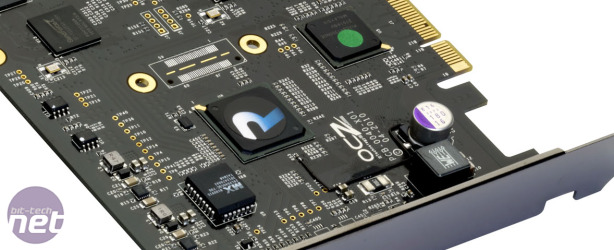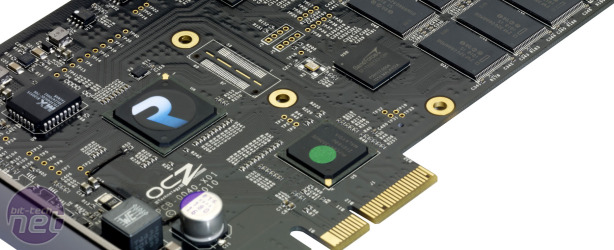OCZ RevoDrive Review: 120GB
September 3, 2010 | 07:38
Companies: #crucial #ocz-technology #sandforce

Performance Analysis
SandForce’s DuraWrite compression technology means that it tends to be relatively slow when dealing with incompressible data, such as is used in the AS SSD benchmark. This is the case with the Revo, as we saw it manage a sequential read speed of 385MB/sec and a sequential write speed of 190MB/sec rather than the quoted 540MB/sec and 450MB/sec. This performance isn’t much beyond that of the Crucial C300 256GB.However, after heavy use these speeds both dropped sharply, resulting in a sequential read speed of just 330MB/sec and a sequential write speed of 138.9MB/sec. All the SandForce drives we’ve tested so far have exhibited this drop in write speed when dealing with incompressible data following heavy use, but the TRIM compatibility has always preserved the high read speed; this is not the case with the Revo.
The ATTO test uses easily compressible data, which is much more to the SandForce drive controller’s liking; it’s no surprise to see the Revo deliver devastatingly fast performance in ATTO. A read speed of 538MB/sec and a write speed of 447MB/sec show just how fast two SandForce drives working in tandem can go. Following heavy use these numbers actually went up, reaching a 537MB/sec read and a 454MB/sec write speed, so despite the lack of TRIM there’s no worry when it comes to performance degradation with compressible files.
Away from sequential read/write performance though, the limitations of RAID start to show. In Iometer, which randomly reads and writes three consecutive patterns of 4KB files, the Revo was barely faster than the Vertex 2E 120GB, with a random read speed of 46.7MB/sec and a random write speed of 85.6.
Even worse, the figure we’ve graphed for the Revo in Iometer is an average of multiple tests, as the card was wildly inconsistent in its performance, especially when it came to random read: the Revo delivered anything between 40MB/sec and 55MB/sec depending on which foot we were standing on, whether Saturn was aligned with Venus or whether we took away its teddy or not. These irregularities in performance have to be blamed on the RAID controller of the card, as no other SSD has exhibited such variable performance.
Despite there being little improvement in regards to random read or write performance, we were surprised to find the Revo was conclusively two seconds faster than a standard SandForce drive when loading games. It took 22 seconds to load STAKER: Call of Pripyat, which is an 8 per cent improvement over the Vertex 2E. As access times and the random performance of the Revo are the same as the Vertex 2E, we suspect the improved bandwidth of the 4x PCI-E connector may be the cause. Still, if loading games in lightning-quick times are the most important reason for buying an SSD, a Crucial C300 (of any capacity) loads STALKER two seconds faster again than the Revo.
Conclusion
While the performance of the Revo when handling compressible files (as in the ATTO test) is fantastic, the obvious performance drop that hits the Revo following heavy use is a huge cause for concern. Following heavy use, the card was actually slower than a Crucial C300 128GB. Having spent the last year worrying about getting TRIM support onto its SSDs with firmware upgrades, for OCZ to release a product that resoundingly ignores it is baffling. Even more worrying is that because the drive controllers sit behind the RAID controller, it’s extremely unlikely that OCZ will be able to deploy firmware upgrades for the Revo.While the Revo does deliver those huge read and write speeds, there’s only a small improvement in real-world speed; even this came as a surprise considering our past disappointments with RAID. Not only does having two drives not equate to twice as much performance, but it also leads to more than a doubling in price. The Revo 120GB is £30 more expensive than just buying two 60GB Vertex 2Es and plugging them into your motherboard’s RAID controller. That might not give quite the level of performance you see in our graphs, but you’ll have £30 to compensate.
The real killer for the Revo (and most SSDs at the moment) is the Crucial C300 range and a SATA 6Gbps card such as the HighPoint Rocket 620. This combination delivers staggering speeds for reasonable prices, and has the benefits of TRIM support. Best yet, a 128GB C300 and that HighPoint card will cost £15 less than the Revo 120GB. While the Revo is an interesting addition to the world of SSDs, it’s unconvincing, over priced and ultimately disappointing; we won’t be ditching our SATA cables just yet.
- Performance
- x
- x
- x
- x
- x
- x
- x
- x
- x
- -
- 9/10
- Features
- x
- x
- x
- x
- x
- x
- x
- -
- -
- -
- 7/10
- Value
- x
- x
- x
- x
- x
- -
- -
- -
- -
- -
- 5/10
- Overall
- x
- x
- x
- x
- x
- x
- x
- -
- -
- -
- 7/10

MSI MPG Velox 100R Chassis Review
October 14 2021 | 15:04










Want to comment? Please log in.